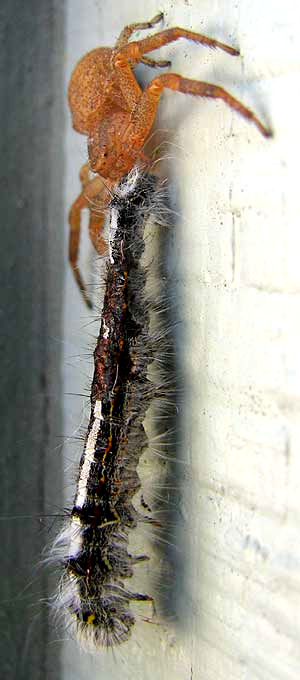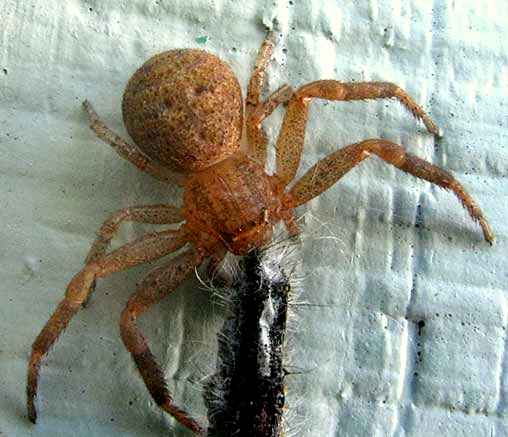Excerpts from Jim Conrad's
Naturalist Newsletter
from the November 4, 2012 Newsletter issued from the valley of the Dry Frio River in northern Uvalde County, southwestern Texas, on the southern border of the Edwards Plateau; elevation ~1750m (~5750 ft); N29.62°, W99.86°; USA
GROUND CRAB SPIDER
 While painting a house this week I ran across a medium-size, orangish crab spider hanging on the outside wall with a partially sucked-dry caterpillar dangling from its mouth. You can see the whole thing at the right.
While painting a house this week I ran across a medium-size, orangish crab spider hanging on the outside wall with a partially sucked-dry caterpillar dangling from its mouth. You can see the whole thing at the right.
A close-up of the spider from above is shown at the bottom of this page.
The spider's characteristic manner of holding its legs out crablike and the fact that no web was present made it easy to recognize this as a kind of crab spider, a member of the Crab Spider Family, the family Thomisidae. However, over 2,000 species of crab spiders are recognized, in about 170 genera worldwide, so recognizing it as a crab spider was just the first step.
Volunteer identifier Bea in Ontario figured out that our spider was one often called the Ground Crab Spider, XYSTICUS FUNESTUS, found throughout most of North America. Members of the genus Xysticus are known to hunt in leaf litter on the ground. The caterpillar looks like a kind of tent caterpillar, and tent caterpillars sometimes range across the ground looking for places to pupate, so one can imagine the drama that led up to the picture.

Crab spiders in general are noted for being able to move forwards, sideways, or backward. They have short, broad bodies and eight small eyes. Their second pair of legs is often heavier and longer than the third and fourth pairs. They don't build webs but rather prowl the ground and climb flowers and plants in search of prey. Many are spectacularly camouflaged, and often they take up position on flowers, their front legs spread out ready to grab whatever prey comes along.